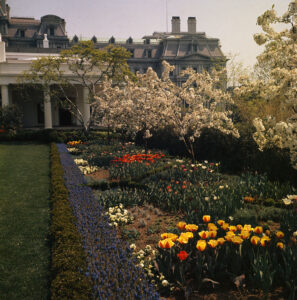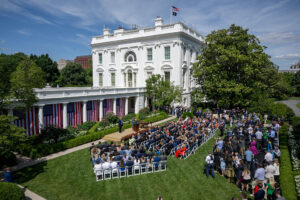It hasn’t yet reached the notoriety and acclaim of Susan Sontag’s “Notes on ‘Camp’,” but few essays have captured the vibe of the last decade better than RS Benedict’s “Everyone Is Beautiful and No One Is Horny.”
Published in 2021 by the online sci-fi/horror magazine Blood Knife, the piece takes an unflinching look at the perfect on-screen bodies of the superhero era. Benedict dives into the normalization of comedic actors putting on 30 pounds of muscle to convincingly wear spandex and crack jokes at alien hordes. These movies fetishize bodies not as sex objects, but as ruthlessly efficient machines. Imagine the shower scenes in Paul Verhoeven’s 1997 film “Starship Troopers” with an extra layer of deadly seriousness, and you’re most of the way there.
Separated from the status plays and classical educations of the Northeastern blue-bloods, the wealthy have crafted a design language with all the warmth of an iPhone screen. White marble, grey floors, cold recessed lighting and open floor plans — call it “everything is expensive and nothing is beautiful.”
A parallel aesthetic has developed in the worlds of architecture and interior design. As the richest people in the world have gone from being oil barons and communications scions to app makers and data center owners, the trappings of wealth have shifted. Separated from the status plays and classical educations of the Northeastern blue-bloods, the wealthy have crafted a design language with all the warmth of an iPhone screen. White marble, grey floors, cold recessed lighting and open floor plans — call it “everything is expensive and nothing is beautiful.”
The tyranny of “greige”
In Umberto Eco’s novel “The Name of the Rose,” a medieval abbey’s library that houses the lost second book of Aristotle’s “Poetics” burns to the ground. How we get to that point is complicated, both because the book is a murder mystery and because its author was one of the foremost thinkers in the field of semiotics. What’s important for our purposes is the motive of the accidental arsonist and intentional murderer. Jorge of Burgos is willing to kill to keep things neat, viewing levity as an affront to God.
Free from centuries-long shadow that the Catholic Church casts over European design, American architecture doesn’t have a god to offend, at least in the traditional sense. Without anything divine to revere, American home and landscape design largely genuflects at the altar of the market. Harvard theologian Harvey Cox pegged this tendency to exalt the Invisible Hand in lieu of a distant and unknowable god before the turn of this century, and it’s held strong through at least three global economic shocks.
Americans remember the 2008 financial crash, when the god of the market wiped the slate clean. Underwater and forsaken, American homeowners watched as their earth-toned Tuscan kitchens and quirky bits of ornament made their homes slow to move in a glutted market. A new class of HGTV high priests shared a novel interpretation of the market’s will. Flippers like Chip and Joanna Gaines, Tarek El Moussa and Christina Hall showed a new path to prosperity through real estate. These investors favored homes with a minimum of quirks, buying them on the cheap and stripping them of anything that might hinder a future sale. Home builders and buyers swore a covenant to never again favor the use value of a home over its exchange value — and to keep resale value in their hearts.
“All of this is a broader symptom of the increasing commodification of the very notion of a dwelling: The home is no longer seen as a space of personal expression or comfort, or as the backdrop of everyday life, but primarily as an investment and as an asset — meaning that enforcing one’s aesthetics is a financially detrimental decision,” architectural critic Kate Wagner wrote for The Nation in 2023. “Those with the capital to become homeowners (already a diminishing segment of the public) conceive of their houses as being for selling before they even live a day in them.”
In practice, this means loads of grey and white. It’s downstream of the phenomenon Kyle Chayka dubbed “AirSpace,” the universal look of coffee shops and coworking spaces that favors concrete floors and gleaming surfaces. A lack of ornamentation turns every place into no place at all, blending together experiences and venues in the same manner as the internet’s endless feed. In 2025, white cabinets and grey floors signify a home with no pesky outré design choices to hinder the viewer’s ability to picture themselves in that kitchen.
Sign of the times
Despite the projected timelessness of the neoclassical building to its east, the Rose Garden isn’t immune from design trends. The former stable grounds near the White House’s West Wing were taken on as a project by First Lady Edith Roosevelt during the 1902 renovation of the White House. With the country deep in the throes of a colonial design revival, Roosevelt envisioned a proper colonial garden on the premises.
Colonial gardens were neat, with walkways leading from the residence through the plant beds. Roosevelt’s take on this framed a series of looping paths with low shrubs and wildflowers. This was torn out by future First Lady Ellen Axson Wilson in favor of a long, symmetrical lawn bounded by roses.

(Bettmann via Getty Images) The Rose Garden, after its redesign by Rachel Lambert “Bunny” Mellon at the behest of John and Jacqueline Kennedy, in full bloom on April 27, 1963
John and Jacqueline Kennedy famously reimagined the garden in 1961, hoping to create a space for hosting inspired by their recent travels through Europe. President Kennedy commissioned Rachel Lambert “Bunny” Mellon, at the time the country’s top horticulturist, to redesign the space. A fellow blue-blood of the type whose prep school education gets a mention in most quick biographies, Mellon designed a continental country garden to counteract WASP-ish fatigue, guided by Jackie Kennedy’s desire to give future presidents a pleasant place to retreat from their stresses.
Despite the French style of the grounds, Mellon’s redesign upped the Americana of the Rose Garden, bounding a green lawn with a selection of trees native to the New World: The waxy-leafed southern magnolia tree, bright pink crab apple trees and beds of colorful tulips that would pop on camera for Kennedy, the nation’s first television president.
Jackie Kennedy and Mellon’s redesign became a cherished icon with the help of television cameras, as JFK and his successors used the garden as the backdrop for important meetings and celebrations of American excellence.

(Wally McNamee/CORBIS/Corbis via Getty Images) President Clinton, joined by Crown Prince Hassan of Jordan and Israel’s Shimon Peres, discusses Mideast peace in the White House Rose Garden.
The stately hedges with looming pops of color have been a constant presence in American politics, looming over meetings between President Jimmy Carter and Egyptian President Anwar El-Sadat, after Carter helped facilitate a peace treaty between Egypt and Israel. Bill Clinton’s two terms are hard to picture without the Rose Garden. He used the grounds as a backdrop for negotiating the 1994 accord between Israel and Jordan, and he addressed the press there in 1999 after his acquittal by the Senate on impeachment charges.
That’s not to say that every use of the Rose Garden has been quite so serious. Barack Obama’s famous “beer summit” was held at a table in the garden and the site typically hosts the annual presidential turkey pardon on Thanksgiving.
That philosophy, anchored by those and other historic events, largely held until 2025 when President Donald Trump reimagined the space as a slab of patio.
Start your day with essential news from Salon.
Sign up for our free morning newsletter, Crash Course.
Mar-a-Lago comes for the Rose Garden
At the same time that flippability has flattened American home design, the algorithm has smoothed out the tastes of Americans across class lines. Where the rich of previous generations could be counted on to spend their wealth on lavish ornamentation and expensive craftwork, social media accessibility has turned tastemaking into a two-way street.

(Jim Watson/AFP via Getty Images) First Lady Melania Trump speaking in the Rose Garden in May 2025 prior to the iconic lawn’s renovation
Trump is a real-estate developer, and it’s not hard to see the last decade of suburb-filtered minimalism in his reworking of the Rose Garden. In the same way that greige American houses prioritize the marketplace over comfort, Trump values clean lines and table space over the serenity of a garden.
The influence of his time in Florida is evident. In the Sunshine State, builders like Toll Brothers and D.R. Horton often push back the organic chaos of a subtropical swamp in favor of paver-stone patios and endless miles of St. Augustine grass. There are also shades of Trump’s beloved Mar-a-Lago. Located on a barrier island between Lake Worth Lagoon and the Atlantic Ocean in South Florida, the club’s landscaping could place it anywhere in the United States. If you were to grab a section of the grounds at random, odds are you would be pulling up a chunk of hot asphalt or stiff-bladed grass.
Following Trump’s redesign, it’s fair to ask if the Rose Garden can now be called a “garden” at all. Gone are the carefully tended beds of flowers and the long expanse of lawn. In its place, the president has put pavement, one giant patio.
There’s no spark, and no consideration for humanity. Trump’s stone garden doesn’t consider how spaces will be used and enjoyed in practice.
Like the Rose Garden redesigns before it, Trump’s take is a statement on the values of the era. It reeks of Silicon Valley’s Patagonia vests and Kim Kardashian’s all-white kitchen islands. There’s no spark, and no consideration for humanity. Trump’s stone garden doesn’t consider how spaces will be used and enjoyed in practice.
After all, his own screen-facilitated presidency no longer has to worry about what looks good on television cameras. The smaller-screen admin and short-form turn allows users to be briefly impressed by hard, clean lines that echo the device they’re using to engage with the world. Before they can think about how uncomfortable it would be to live in that world, the endless scroll shuffles them along to another pristine box. Trump’s Rose Garden seems meant to look pricey from a distance of around a foot and a resolution of 740p.
While bemoaning the antiseptic, “look, don’t touch” aesthetic of modern cinema, Benedict did find time to tie it to the way we live, saying that the inhumanity of modern homes has crept into our bodies.
“Features exist to increase the house’s resale value, not to make it a good place to live. No thought is given to the labor needed to clean and maintain these spaces. The master bathroom includes intricate stone surfaces that can only be scrubbed with a toothbrush…the chandelier in the grand entryway dangles so high that no one can replace the bulbs in it,” they wrote.
Our homes and bodies, per Benedict, are “no longer holistic system[s]. We’ve lost the “vehicle through which we experience joy and pleasure” and the idea that a home is a place “to live in and be happy.”
So it is that the first truly post-social media president has brought the scrubbed and anesthetized taste of the internet to the White House grounds.
Read more
about this topic


